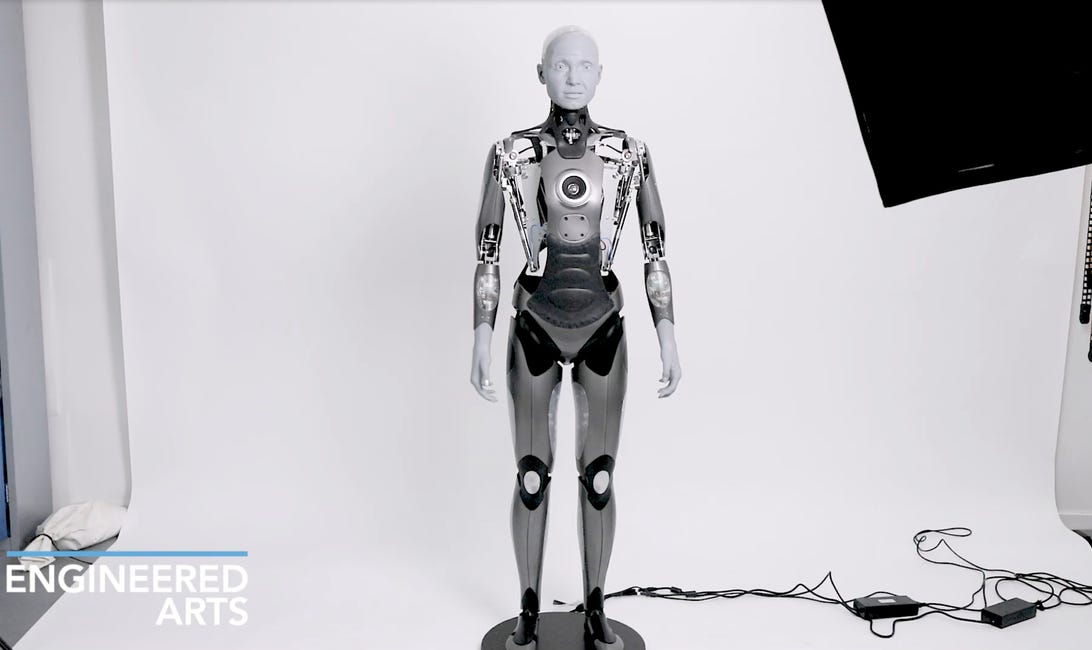Philip K. Dick famously contemplated whether androids dream of electric sheep. My question is far more direct: If you poke a robot in the face, is it going to try to kill you?
Interviewing Ameca the robot during a demo at CES, I got my answer: No, but the face it makes when you get up in its personal space is haunting and mesmerizing in equal measure.
If you’re on the internet, you’ve probably seen Ameca. The gray-faced, humanoid robot blinked its way into the public consciousness in late 2021 when a video of its facial expressions went viral on social media. Elon Musk responded to the video with one word, “Yikes.” Chrissy Teigen retweeted it to her 13 million followers with four words: “absolutely. the fuck. not.”
But while Ameca had some people running for the hills, its creators at UK company Engineered Arts were delighted.
“We were incredibly surprised,” says Morgan Roe, Engineered Arts’ director of operations. “Overnight, it became a sensation. We got 24 million views on one Twitter post.”
Roe puts it down to Ameca’s not-quite-robot, not-quite-human appearance. Its body is all metal and plastic, its face is a deliberately genderless and nonhuman gray. It has 17 individual motors inside its head controlling its movements and expressions. But its facial features are surprisingly vivid and emotive. And it’s this combination of artificial and lifelike that Roe says speaks to our collective vision of what humanoid robots will look like in the future.
“We’ve all seen it in the movies, we’ve all seen iRobot and A.I. Artificial Intelligence,” he says. “And suddenly, that’s real.”
Roe is speaking to me via Zoom from the show floor of CES, where Ameca is being shown to crowds, in the latex flesh, for the first time. Even though I’m seeing Roe and his robot over a Zoom call, it’s hard to shake just how real Ameca looks. I find myself distracted. I’m no longer speaking to the very friendly human Englishman I’m supposed to be interviewing. My eyes are straying over to Ameca’s face to see how it’s responding to our conversation. A furrowed eyebrow ridge, the twitch of a smile. Ameca isn’t human, and yet…

Engineered Arts’ previous humanoid robot, Mesmer (on the left).
Engineered Arts
This isn’t the first hauntingly humanoid robot Engineered Arts has released. For the past four years, the company has been creating a line of lifelike Mesmer robots and showing them to conferencegoers on crowded show floors.
“Each Mesmer robot is designed and built from 3D in-house scans of real people, allowing us to imitate human bone structure, skin texture and expressions convincingly,” the Engineered Arts website tells prospective clients. “Mesmer is designed to be modular, so you can remove the head with one click and no tools, and swap it for another.”
Princess Mombi, eat your heart out.
Ameca isn’t destined for the conference circuit. It doesn’t run and jump like the robots created by Boston Dynamics, and it’s not something you can preorder now as a household helper. Roe says it’ll be at least 10 years before a robot like Ameca is “walking amongst us” as a service robot. Sure, Walking Among Us sounds like the title of the documentary that’ll eventually chronicle the decline of humanity, but we’ve got another decade before we need to worry about that.

Ameca’s humanoid body is made of metal and plastic — decidedly nonhuman and human at the same time.
Engineered Arts
Ameca also doesn’t have Mesmer’s flesh-colored skin tones. In place of the lifelike human hair on Mesmer’s head, Ameca has a translucent plastic skull. We see the robot’s joints and parts. Ameca is still undoubtedly “other,” and that’s deliberate.
“What we found was, when you try and make it look ultra lifelike [like] our other Mesmer line, it looks a bit more sinister, because it’s right in the uncanny valley,” Roe says. “But when we created Ameca, we pulled it backwards out of the uncanny valley.”
Of course, as Roe is saying these things to me over our Zoom call, Ameca is responding. Raising its eyebrows at people walking past. Subtly moving its lips (or, more accurately, the actuators around its mouth hole) as though trying to ape the speech of its human creator.
“Because it looks less human…” says Roe, while Ameca smiles into the middle distance.
“Because it’s plastic, because it’s metal…” says Roe, Ameca glancing over at him with a vague smile.
“Because it’s of gray skin, it’s suddenly…” Roe waves his hand near Ameca’s face and the robot leans back, startled.
“Ooh, hello,” says Roe, making eye contact with the humanoid and leaning back in startled unison. He’s lost his train of thought.
“It’s suddenly, uh, less — less scary.”
I’m struck with the urge to ask the question I’ve been thinking all along. The question I’ve wanted to ask since I first saw the video of Ameca in the lab, with its engineer/programmer hunched over a laptop and another identical Ameca moving slowly in the background.
“When you’re in your offices, working late into the night on some extra lines of code, do you ever do a double take or have to check behind you, at the robot, to see if it winked at you?” I ask.
“Actually no,” says Roe. “When you’re working with it day to day, it’s suddenly, definitely a robot. And a lot of the time, you’ll see one of the engineers walking through the workshop, not with a robot, with just the head. And you have to distance yourself from it being a human. Otherwise, then it’s really sinister.”
Credit: Source link



